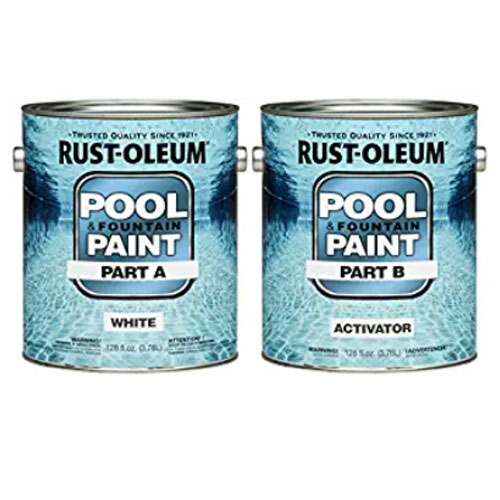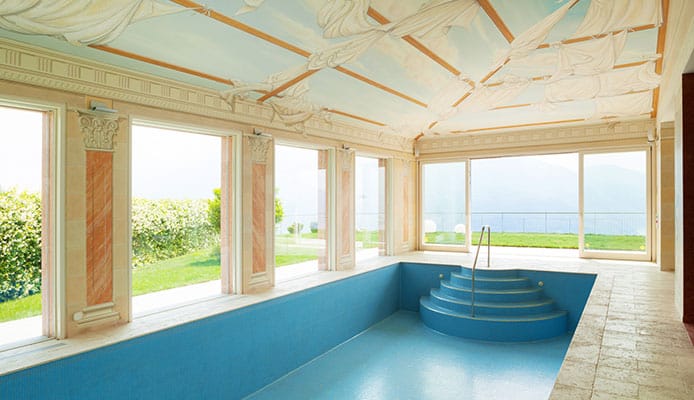
Whether you’re building a new pool or your old one looks a bit tired, a new lick of paint can do wonders. Of course, you can’t use just any regular paint to do this – you need a specialized pool paint. Because of the constant exposure to sunlight and chemicals, the pool paint needs to be a lot more resilient.
Finding the right one depends on several factors: materials used to make the pool, whether there’s existing paint or not, the durability you expect, and how much you are willing to pay. The pool paint should also be fairly easy to apply to your own.
Our buying guide will walk you through this process and help you decide what can or can’t work for your swimming pool. Also, be sure to check out our reviews where we go over a few great options that will make every pool look fantastic.
OUR TOP PICK
Rust-Oleum
- Stand Out Features - Why We Love It
- Performs great on concrete and plastered pools
- Dries to the touch in just six hours
- Multiple coatings provide years of protection
- Large 5-gallon package is very economical
Type: Acrylic
Surfaces: Concrete, plaster
Coverage: 125 to 150 sq.ft. (1 gallon)
Curing time: 4 to 6 hours (touch)
Volume: 5 gallons
EDITORS CHOICE
In The Swim Super Poxy Shield
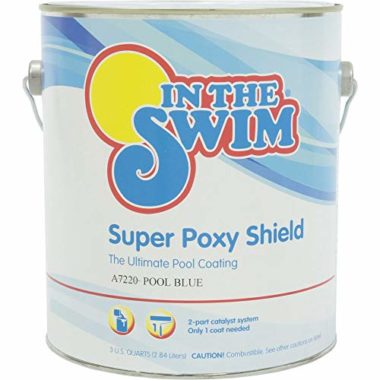
- Stand Out Features - Why We Love It
- Pool blue color looks amazing on any surface
- More durable than other options (up to 8 years)
- Excellent resistance to stains and fading
- Smooth tile-like finish when it dries
Type: Epoxy pool paint
Surfaces: Concrete, plaster, gunite, fiberglass
Coverage: 125 to 150 sq.ft. (one gallon)
Durability: 7 to 8 years
Curing time: 6 days (65°F)
Volume: 1 gallon
BEST VALUE
AdCoat Swimming
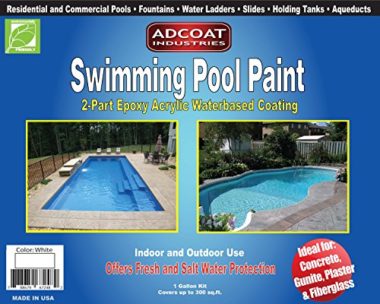
- Stand Out Features - Why We Love It
- Excellent for pools, ladders, slides, and fountains
- Unique formula prevents fading and chalking
- A single gallon covers up to 300 square feet
- Very easy to mix and apply
Type: Epoxy Acrylic
Surfaces: Concrete, gunite, fiberglass, plaster
Coverage: 300 sq.ft. (one gallon)
Volume: 1 gallon
Complementary Coatings Rubber-Based Swimming
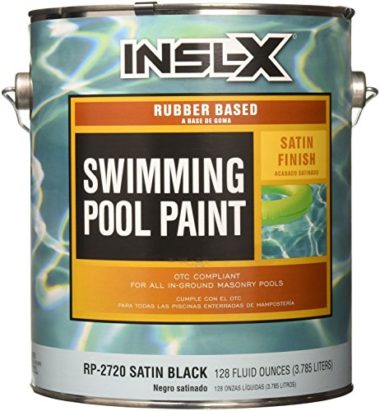
- Stand Out Features - Why We Love It
- Black color adds a great look to the pool
- Complies with all VOC regulations
- Easily removable with xylene
- Larger coverage than most other paints
Type: Rubber
Surfaces: Concrete, marcite, bunite
Coverage: 400 to 500 sq.ft. (1 gallon)
Volume: 1 gallon
INSL-X Waterborne Semi-Gloss
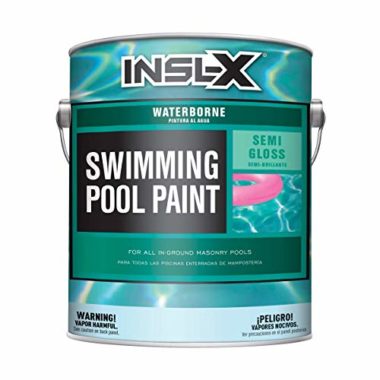
- Stand Out Features - Why We Love It
- Works well on almost all existing pool paints
- Right paint for all masonry surfaces
- One gallon easily covers up to 400 square feet
- Designed to provide longlasting protection
Type: Acrylic
Surfaces: Concrete, marcite, gunite, and other masonry surfaces
Coverage: 300 to 400 sq.ft. (1 gallon)
Curing time: 7 days for the first application, 4 to 6 hours for recoating
Volume: 1 gallon
How To Choose A Swimming Pool Paint – Buying Guide

Type Of Paint
Because they are exposed to harsh pool chemicals and UV rays, pool paints need to fulfill much higher quality standards than regular paint. Three types of paint are used for painting a pool – epoxy, acrylic, and rubber, each with its pros and cons.
When choosing a paint, keep in mind that it needs to be compatible with the pool surface you plan to apply it on. And, if your swimming pool was already painted, the new coating needs to be compatible with the old one so it can stick. When describing each type, we will explain how and where you can use it.
Epoxy pool paint
Epoxy paint is the most durable option you can get. It forms a very thick layer, so it’s a good option for covering small cracks and irregularities on the walls. Take a quick look at what you can expect with this paint:
- More durable than any other paint lasts 5-8 years on average
- The thick consistency is good for making a cracked surface flat
- Only paint that works well on fiberglass pool surfaces
- Completely smooth but a bit slippery to walk on
- Takes a longer time to cure than other types (several days)
- Fairly expensive (compared to others) and difficult to apply
Acrylic pool paint
Acrylic paint is a bit easier to work with and much more affordable. Unlike other types, you can use it even on slightly wet surfaces. On the other hand, water-based acrylic much less durable than epoxy paint. Here’s a brief breakdown:
- Least durable paint option, 2 to 4 years on average
- Good choice for unpainted concrete, plaster, and many pools that are already painted
- Requires no mixing (unlike epoxy pool paints) and is much easier to work with
- Costs much less than both chlorinated rubber and epoxy paint
- It usually dries within 3 days, but some paints dry even faster
- Not a good option for covering cracks or stains
Rubber pool paint
Even though it has certain advantages, the use of chlorinated rubber paints is slowly getting abandoned. The reason for this is that most contain polychlorinated biphenyls (PCBs) that present a health hazard. In addition, they can also contain volatile organic compounds (VOCs). Here’s what they offer:
- Flexible paint layer that resists damage well
- More affordable and easier to use than epoxy paint
- Very decent average durability (up to 5 years)
- Contain PCBs that are dangerous to the health
- Contain volatile substances
Size Of The Pool
When considering how much paint you need, start with establishing the surface area that needs to be covered. Working out the square footage can be complicated, and you can find many good online tools out to help you out with this.
By knowing an approximate area you need to cover, you’ll be able to get the right amount of paint and avoid being short on it or having leftovers. In addition, a gallon of two different paints often won’t be able to cover the same area. And if you plan to apply multiple coatings, be sure to consider that too.
You might also like: Best Diving Boards
Quality And Durability
Since pool painting isn’t something you do every year, it’s perfectly natural to have high standards regarding the quality and durability of the paint you buy. You want a product that can cover the surface of your pool well (doesn’t leave bubbles or cracks) and that can resist several years of exposure to the sun and pool chemicals.
Like we’ve mentioned when discussing types, epoxy paint is the most durable – a quality paint in multiple layers can look fantastic for up to 8 years. However, it’s fairly expensive and not very easy to use.
Acrylic is the least durable, although it can also last for many years if done properly. Rubber paint falls somewhere in the middle (around 5 years), but be careful about the particular product you’re buying because of the health hazards we mentioned.
FAQs
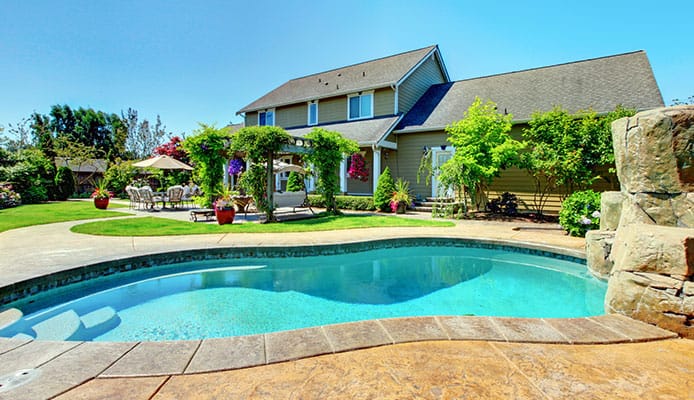
Q: How Should I Prep My Pool Before Applying The Paint?
- Wait for a good weather forecast (5 to 7 days with dry weather and temperatures between 40 and 90°F)
- Drain the pool water completely
- Pick up all the remaining water and debris so the surfaces are clean and dry
- Use a scraper to remove any loose material (old paint, concrete, plaster)
- Sanding the pool is also an option, but it’s expensive and difficult to do
- Patch the cracks with some type of waterproof cement so everything is nice and flat
- Pressure wash the pool and preferably scrub it with TSP (trisodium phosphate), then rinse and let dry
- When completely clean and dry, you can start with painting the pool
Q: Do I Need A Primer?
It depends on the paint you use and on the surface underneath it. A primer preps the surface and enables better adhesion once you apply the paint. For example, many epoxy swimming pool paints require a primer if you use them on unpainted concrete. If you’re painting over existing paint, you maybe won’t need a primer if you’re using the same type of paint.
Q: Can I Paint My Pool By Myself Or I Need A Professional Do It?
While the initial pool preparation is going to take some time, the actual painting of the pool isn’t going to be that technically difficult. Premium acrylic paint is most DIY friendly and you should be able to do the job yourself without troubles (if you have a smaller pool). On the other hand, if you have a very large pool or don’t know how to work with epoxy paint, calling a professional is a good option too.
Q: How Long Does Pool Paint Last?
While this depends on the type of paint you use, you can expect it to last from 2 to 5 years on average. As we’ve mentioned earlier, epoxy pool paints are the most durable and can last up to 8 years. On the other hand, premium acrylic paint lasts from 2 to 4 years, so you’ll have to refresh it more often.
Q: How Long Does Pool Paint Take To Dry?
Similarly to the previous question, it depends on the type of paint. Epoxy paints are thicker and have a much longer drying time which can go up to a week in some cases. On the other hand, the best water-based acrylic paints can completely cure within 24 hours. As you can see, it varies greatly from product to product.
Q: Can You Paint A Pool With Water In It?
No, unfortunately, you can’t. For the paint to adhere well to the wall, the surface needs to be completely dry (especially for epoxy and chlorinated rubber paints). Water-based acrylic paints tolerate a moist surface to a degree, but you’ll have to empty the pool regardless of the paint you choose.
Q: How Much Does It Cost To Paint A Pool?
It depends on the paint you choose and how many layers you want to apply, but we’ll try to give you a reference. Let’s say you have a small 20 x 10ft pool that is 4 feet deep – you’ll have to paint a surface area of 440 square feet (bottom and walls). If you wish to apply a second coating (recommended), this goes up to 880sq.ft.
A gallon of our value paint (AdCoat) can cover up to 300sq.ft. which means you’ll need three of these, for a total cost of around $215 (for our imaginary pool). On the other hand, an epoxy paint like In The Swim Super Poxy will cost around $600 for the pool of the same size.
Q: Why Is My Pool Paint Bubbling?
The main reason for swimming pool paint blistering or bubbling is bad preparation before you applied the paint. The most common causes are dirt or moisture on the surface before painting. To avoid this, be sure to prepare the surface properly (clean and dry it). High temperatures can also be the underlying cause, so it’s best to paint the pool during the off-season.
Q: Why Is My Pool Paint Chalking?
The cause of swimming pool paint chalking is bad pool chemistry. Continuously high chlorine levels are the main cause of this (when you shock the pool several times), but low pH is also a big contributor. Unfortunately, if the paint starts chalking, the best solution is to re-paint the pool.
Globo Surf Overview
A fresh coat of paint is a fantastic way to improve how your pool looks. Not only this, but the best pool paint will also provide a means of protection to the pool walls and help them last longer. This is why choosing the right paint and applying it properly is so important.
With all the info we provided, deciding on the best option, and making an informed choice won’t be that difficult. Repainting the pool will make it look like new and allow you to fully enjoy using it.
More Pool Accessories Reviews:
- Pool Lounge Chairs
- Pool Speakers
- Pool Umbrellas
- Pool Cover Reels
- Pool Fences
- Pool Toys
- Solar Pool Covers


